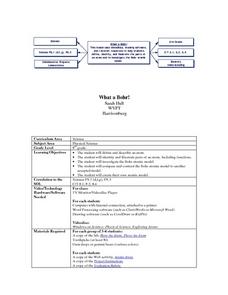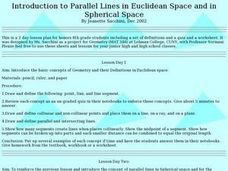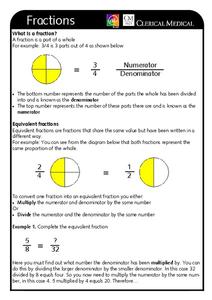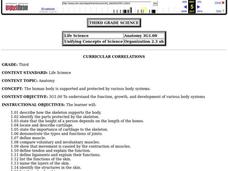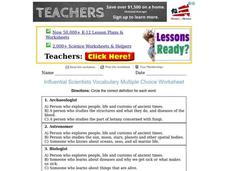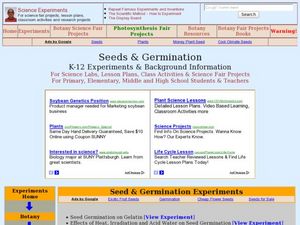Curated OER
What a Bohr!
Students define, identify and illustrate the parts of an atom, and investigate the Bohr atomic model. Students watch a multimedia presentation to understand an atom's parts and their functions. In groups, they create a model of an atom...
Curated OER
By Any Other Name
Young scholars examine the differences between the definitions of race and ethnicity defined by the United States government. After reading an article, they discuss the possiblity of the elimination of some races from the 2010 census....
Curated OER
Introduction to Parallel Lines in Euclidean Space and in Spherical Space
Eighth graders are introduced to the basic concepts of Geometry and their definitions in Euclidean space. They draw and define the following terms: point, line, and line segment. Students also define the terms colliner and...
Curated OER
Influential Scientists Vocabulary Quiz
For this science vocabulary worksheet, students match the names of 19 science professionals with the definition. Example: Ichthyologist (studies fish).
Curated OER
The Geometry of Circles
Young scholars review the parts of a circle, calculate the circumference and area of a circle, and create student-made tests on the geometry of circles using educational software.
Curated OER
Inflation: Taking Prices Higher
Students examine the definition of inflation and its impact through history. They read and discuss online text, discuss examples of inflation, calculate the prices of various items for different years using an inflation rate of 3%, and...
Curated OER
Fractions
For this math worksheet, students will read about the definition of fractions. Students will read about and practice equivalent fractions, simplifying fractions and adding and subtracting fractions.
Curated OER
Lesson 1 - What Are Fossils?
Students define and research fossils. In this fossil instructional activity, students access teacher assigned Internet sites to examine images of fossils. They determine the definition of a fossil and find out how fossils are formed....
Curated OER
Eye No the Write Won!
Second graders practice with synonyms, antonyms, and homophones. After listening to a Berenstain Bears story, 2nd graders utilize worksheets imbedded in this plan to gain practice identifying these parts of speech. A nice lesson plan!
Curated OER
To Float or Not to Float, That is the Question?
Ninth graders develop operational definition of density, do computations using density equation, categorize pieces of matter as being able to float on
water or not, based on density, explain why some objects sink or float based on...
Curated OER
Skeletal System
Third graders describe and identify the parts of the skeleton and how they support the body. They observe two chicken bones that have been soaked in vinegar for 5 - 7 days. They observe the bone's appearance after it has been removed...
Curated OER
Wave Superposition: Interactive On-line Mac and PC
Young scholars study definitions of wavelength, wave speed, wave amplitude, and wave period using an interactive JAVA environment. Distance and time are given so speed=wavelength/period can be verified or deduced by students. Waves...
Curated OER
7th Grade Math Circle Graphs
Seventh graders are able to develop (synthesis) pie graphs with the class and on their own. They are told that pie charts are a graphic representation of material that can be given in the form of parts of a whole by using...
Curated OER
An Introduction to Opera: The Emperor's New Clothes
Fifth graders are introduced to opera, its vocabulary, definitions and are given an opportunity to listen to an opera sung by children. They identify phrases and events in the story, "The Emperor's New Clothes." Each student creates a...
Curated OER
Similarity and Congruence
Students determine that two figures are similar or congruent by
investigating figures that are similar and figures that are congruent. They prove that two figures are similar or congruent by using definitions,
postulates, and theorems.
Curated OER
Mystery : Structure of the Atom-A Case for Indirect Evidence
Students investigate the structure of the atom through hands on activities. In this atomic structure lesson, students perform 4 activities showing indirect evidence of the structure of the atom and the parts of the atom. They also list...
Curated OER
What's Your Genus? Scientific Classification and the VT
Students understand the definition of binomial nomenclature. In this binomial nomenclature lesson, students classify ordinary animals by seeking their scientific names. Students participate in a knowledge hunt using binomial nomenclature.
Curated OER
China Vocabulary Quiz
For this recognizing meanings of words worksheet, students match words about the country China with their definitions. Students match 16 answers.
Curated OER
Influential Scientists Vocabulary Multiple Choice Worksheet
In this science vocabulary worksheet, students read the names of science professionals. From three choices, students choose the correct definition for each word.
Curated OER
Lions at Lunchtime
In this literature study unit, 4th graders read the book Lions at Lunchtime and match ten vocabulary words to the definitions and seven short answer questions based on chapters 1 and 2. Students read chapters 3,4, and 5 and answer twelve...
Curated OER
Choose Your Toy
In this decision-making worksheet, students choose 1 out of 6 toys for a young boy. Students match 7 vocabulary terms to their proper definitions. Students fill in 3 blanks in 2 sentences. Students complete a variety of assignments about...
Curated OER
Seeds & Germination
Students study the types and parts of seeds and how they have evolved. In this germination lesson students complete experiments that show the effects of variables role in seed germination.
Curated OER
Symbolism
Students engage in a lesson about symbolism while reviewing the work of Edgar Allen Poe. They review the definition of symbolism and use it to list the symbols in his work. They write a journal about how the author uses many literary...
Curated OER
Imperial Notions
Students research how and why different parts of the world were colonized, considering the pros and cons for both the rulers and the ruled.
